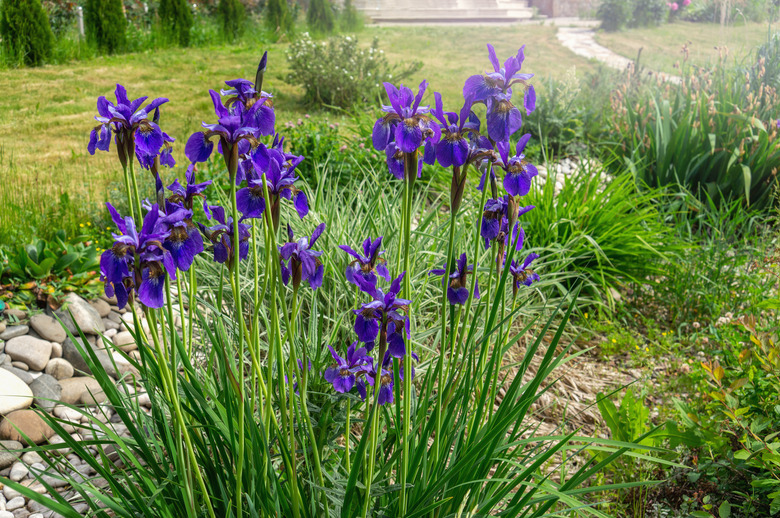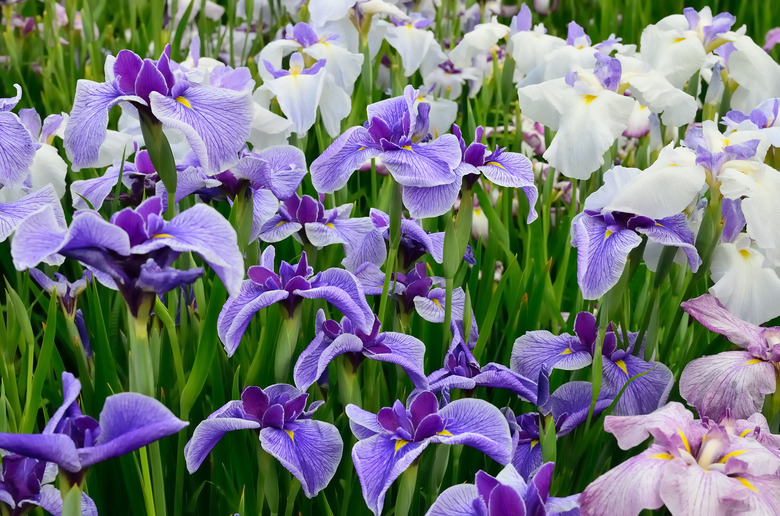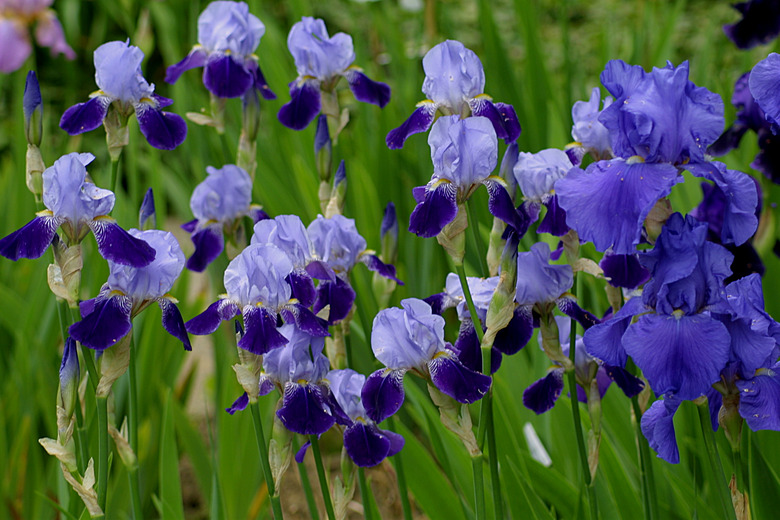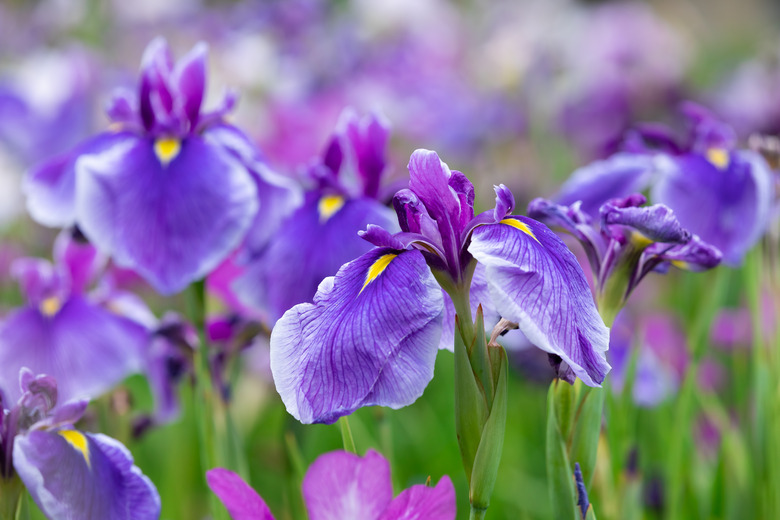How To Grow Iris
We may receive a commission on purchases made from links.
The flower of the iris (Iris spp.) plant is iconic. It adorns the French fleur-de-lis standard, symbolizes the city of Florence, Italy and has been a mainstay in Asian garden design — particularly Japanese — since at least the 12th century. Often associated with royalty, the iris is named after the Greek goddess Iris, who rode rainbows, and it's a multicolored feast for the eyes in any garden setting or in any cut-flower arrangement. All in all, about 300 different species of the genus Iris grow wild or are cultivated in gardens throughout the world, and they run the gamut of hues, from whites and yellows to blues, purples and reds, with some flowers displaying several colors and others displaying only one.
The iris is a perennial that has something in common with pirates: It can be bearded or beardless, which as far as an iris is concerned means it may or may not have fine hairs on the three petals that hang down from the stamen. Besides these petals, which are known as falls, all iris also have three upright petals, called standards, and the falls and standards are often different colors. A particular type of beardless iris known as crested iris displays a ridge on the falls instead of individual hairs.
The bulk of bearded iris, including German iris (Iris x germanica, USDA zones 3-10) as well as the Japanese (Iris sanguinea) and Siberian iris (Iris sibirica), both hardy in zones 3-8, grow from a rhizome, which is a stem that runs horizontally along the surface of the ground, while a few beardless species, including the Dutch iris (Iris hollandica, zones 6-9) grow from bulbs. Leaves are typically long and spearlike, and flowers bloom in different parts of the summer depending on variety. Some species of Japanese iris (Iris japonica, zones 7-9) need good drainage while other species of Japanese irises (Iris ensata, zones 4-9), favor damp soil and are often found by streams.
Best Uses for Iris
Best Uses for Iris
The iris is a stately plant with a complex, showy flower that adds class to any flower garden. It's a clumping plant that will self-propagate if left alone, so once established, it provides a yearly show of color in the garden and a supply of cut flowers for indoor display. Because different iris species bloom at different times of the season, you can combine them to prolong the showy display. The show starts with dwarf iris, which blooms in early spring, followed by bearded (German), Siberian and Louisiana iris and finishing with Japanese and Dutch iris, which bloom in early summer.
After they bloom in spring or early summer, iris flowers wilt and turn brown in preparation for seeding, and the patch of ground they occupy contains only their foliage. A good way to offset this is to plant later-blooming species alongside iris, including foxglove, poppy, black-eyed Susan, daisy, sedum, and a host of others. If you prefer to complement the showy colors of iris while it's in bloom, combine it with violets, peonies, tulips, or daffodils.
Iris is a famously hardy perennial and can withstand years of neglect and overcrowding by weeds, so once established in your garden, iris plants are a reliable source of color for years to come. You can use them along walkway borders or as foundation plants as well as the main show in the flower garden. The large, showy flowers attract bees and hummingbirds and provide plenty of cuttings for flower arrangements and bouquets. Clumps tend to get overcrowded after a few years, and the blooms become smaller and less vibrant. This is easily remedied by cutting the rhizomes and replanting them in another part of the garden.
How to Grow Iris
How to Grow Iris
How to Start Iris From Seed
The most common way to start iris is by planting a bulb or a section of rhizome, but it is possible to start the plant from seed, which is preferable if you're planting a large crop for cut flowers or nursery stock. Seeds are less likely to be infected by soil diseases that rhizomes can carry.
- Iris seeds need to be cold-stratified for at least a month before planting, which you can do by mixing them with sand or peat moss and a little water — or between two sheets of moist paper towels — and placing them in the refrigerator. Some gardeners recommend dunking them in boiling water for a minute after stratification.
- Sow three to five stratified seeds 1/16 to 1/8 inch deep in a biodegradable pot and keep the pot indoors under grow lights at a constant temperature of 65 to 70 degrees Fahrenheit until the seeds sprout, which takes 28 to 35 days.
- When the sprouts emerge, plant the entire pot outdoors.
- Soak the pot and split the sides with a knife to allow the roots to stretch out.
In What Zone Does Iris Grow Best?
In What Zone Does Iris Grow Best?
Depending on the species, iris are hardy in USDA zones 3 to 10, but the actual growing range of each species is a little different. Most species grow well in zone 5, but some, such as the Rocky Mountain iris (Iris missouriensis), is hardy to zone 3. Because iris needs plenty of sunlight to realize its bloom potential, only sunny locations in the North are suitable, but growers in more southern zones have more leeway in choosing a planting site.
When Should You Plant Iris?
When Should You Plant Iris?
The best time to plant iris rhizomes or bulbs is in the late summer or early fall, which gives the roots time to get established before the winter freeze sets in. Bearded iris begin to go dormant in late summer and are best planted in the fall. Planting time isn't critical for rhizomes and bulbs, so if you obtain some at other times of the year, it's better to plant them than it is to leave them out waiting for the perfect time. When starting iris from seed, you should be transplanting the seedlings in the early spring as soon as all danger of frost has passed.
Soil, Sunlight and Water Recommendations for Iris
Soil, Sunlight and Water Recommendations for Iris
Some iris species do well in wet locations, but most prefer well-draining soil and will suffer if planted in low-lying soil where water collects. In areas with a lot of rainfall, plant iris on mounds, in raised beds, or on sloping ground. Soil should be neutral to slightly acidic and should be loosened to a depth of 12 to 15 inches and turned with compost and other organic matter. Ideally, iris should receive at least a half day of full sun, and they should not be planted close to any other plant that shades it.
How to Propagate Iris
How to Propagate Iris
You can propagate iris by seed or by planting rhizomes or bulbs depending on the species. Planting rhizomes is the most common propagation method, and you can purchase them from a garden center or online source, or you can obtain rhizomes by dividing your existing iris plants. Iris plants tend to clump together tightly after a few years and need to be divided to ensure good blooms anyway, so you might as well replant the rhizomes and spread the iris flowers around the garden.
The best time to divide iris plants is six to eight weeks after the flowers bloom, which gives the rhizomes time to regenerate themselves after nourishing the flowers.
- Dig up a clump — foliage, rhizomes and all — and trim the foliage to about 4 inches so the energy of the plant goes into the roots.
- Plant the rhizomes just under the soil surface in fertile and well-turned soil in early fall. The rhizomes must be exposed to the elements, or they won't flourish, and you'll get no flowers, so plant them just deep enough for the tops to be exposed.
- If you plant more than one set, space them by 1 to 2 feet.
If you're planting a species of dwarf or Dutch iris that grows from a bulb, the best time of year to plant the bulbs is in the fall, and the procedure is similar to planting tulip bulbs.
- Dig a fairly shallow hole about 3 to 4 inches deep.
- Place the bulb in the hole, cover it with soil, and water well.
- Space the bulbs 2 to 4 inches apart, and cover the ground with mulch to help the bulbs weather the winter freeze.
How to Winterize Iris
How to Winterize Iris
Iris goes dormant in the winter, but if you're planting new rhizomes, it's a good idea to protect them with mulch, and don't forget to remove the mulch in the spring so the rhizomes can breathe when they come back to life. Remember that they need good drainage, especially in the winter, so plant them on high ground, on slopes or on mounds to avoid subjecting them to standing water, which they definitely don't like.
How to Harvest Iris
How to Harvest Iris
If you want iris flowers for an arrangement, you can cut them at any time, but the best time is just before they reach full bloom. If you leave the flowers in the garden, deadheading them after they have finished blooming may produce a second bloom depending on the species or cultivar.
To collect seeds for sowing:
- Observe the flowers as they wilt after blooming and note that the ones that have been fertilized have a small green pod.
- When the pod eventually expands, turns brown and splits open, cut the stem to which it's attached and let the pod fall into a bag.
- Take all the pods you have collected in this way indoors and extract the seeds. The ones with a hard, dark coating are ripe and can be put into cold storage for sowing next year.
Don't be surprised if the flowers that grow from the seed don't look the same as the ones from which you obtained the seed. Most iris plants are hybridized, and the seeds retain characteristics of the species that comprise the hybrid as well as the plant that produced the seed.
Common Pests and Other Problems for Iris
Common Pests and Other Problems for Iris
The bane of iris plants is the iris borer, a caterpillar that feeds on the leaves and the rhizome. In early spring, it's most commonly found in the leaves, which develop water-soaked streaks and can be easily picked off. It migrates to the rhizome later in the season, causing browning and wilting of the leaves, and at this point, you have to dig up the rhizome to find the caterpillars. Treating the plants with spinosad insecticide can help, as can introducing beneficial nematodes into the soil to attack the caterpillars.
Other pests that affect iris, such as whiteflies, thrips and aphids, can be controlled by spraying insecticidal soap. You can also remove them by spraying the leaves with a strong jet of water.
Common Diseases for Iris
Common Diseases for Iris
Fungal diseases such as leaf spot, which forms brown spots on the leaves that expand and eventually kill the leaves, and ink spot, which is similar, are caused by a fungus and can be controlled with a fungicide. Soil infections, such as crown rot and Botrytis rhizome rot, which attack the rhizome and cause stunted leaf growth, can only be resolved by removing infected plants and discarding them.
Bacterial leaf blight, which causes water-soaked spots on the leaves, is not difficult to treat and prevent. Simply remove affected leaves and in the future, water the plants at the base and avoid getting the leaves wet. As soon as the plant dries out, the bacterium causing the infection dies.



